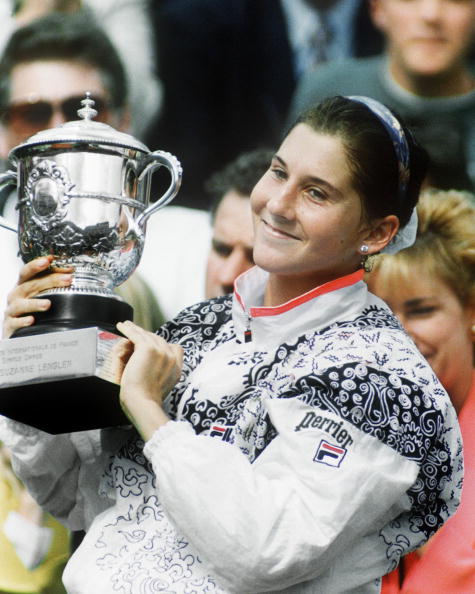
In recent years the sport of tennis had to contend with a large match-fixing scandal. The eyes of the world were on the sport to see how it would respond. But in 1993 another major event in the tennis world had lasting effects on all sports: the stabbing of Monica Seles.
Monica Seles was born in 1973 in Yugoslavia. She began playing tennis at the age of five, coached by her father. In 1986 she moved to Miami, Florida where she enrolled into the Nick Bollettieri tennis academy. In 1988, she played in her first professional tennis tournament; she was just 14. The following year she turned professional, becoming a full-time tennis player. She won her first title in May of 1989, beating Chris Evert in the final. She made it to the semi-final of the French Open that year where she lost to Steffi Graf. She ended the year ranked number 6 in the world.
She won her first grand slam title in 1990 at the age of 16 (the youngest woman to ever win the tournament). In 1991 Monica dominated the sport, winning three of the four grand slams (Wimbledon was the only one to elude her). She repeated this in 1992, making it to the final at Wimbledon where she lost to Steffi Graf. She ended the year as the number one ranked player in the world.
Seles started 1993 by winning the Australian Open, defeating Steffi Graf in the final. On April 30 of that year her life was changed forever. During her quarterfinal match at a tournament in Hamburg, the 19 year old Monica was stabbed by a man who ran onto the court from the stands. Seles was rushed to hospital and her attacker was quickly arrested. Luckily for Seles her injuries were neither life nor career threatening, and she was released from hospital a few weeks after the attack. She would not return to tennis for over two years, however.
Her attacker told police that he had been planning the attack for a number of weeks, however it was not his plan to kill Seles. During the trial his lawyers argued that he had a personality disorder and his admiration for Steffi Graf had reached an unnatural level. He attacked Seles because she was the closest rival to Graf at the time. The judge ruled that it was not attempted murder but attempted assault, and gave him a two year suspended sentence.
Due to the light sentence her attacker received, Monica never set foot on German soil again. In an interview she said: “Germany is the country where that man attacked me from behind, yet was not sufficiently punished. I cannot understand why this man did not have to pay for his crime.”
Seles struggled mentally following the attack. She became depressed and developed a binge-eating disorder. She eventually returned to tennis in 1995, and in 1996 she won her ninth and final Grand Slam title in Australia. She played her last tennis match in 2003, formally announcing her retirement in 2008. In 2009 she was inducted into the International Tennis Hall of Fame.
While the attack had an obvious long-lasting impact on Monica Seles it also had an impact on the wider tennis world, as well as sport in general. At every tournament there are security guards on the court as well as surrounding the players. They are even with them at practice sessions. The same precautions are taken at every sport venue with people’s bags being searched on the way in to ensure everyone’s safety.
-Michelle O’Brien
Contributing Writer
Girl Museum Inc.
